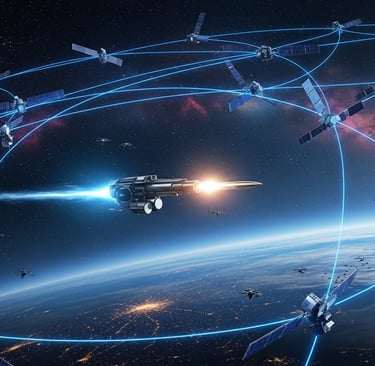The God's Trigger: A Piece of Fiction
Imagine a futuristic space-based system of interconnected satellites orbiting Earth, beaming data to a sleek weapon platform that launches precision strikes—like a cosmic network of eyes and arms in the stars, blending high-tech surveillance with unstoppable force.
TECHNOLOGYINNOVATIONARTIFICIAL INTELLIGENCEDEFENSE
Suraj Prasad
7/15/20253 min read


Disclaimer: The content in this article is entirely fictional and bears no resemblance to any real persons, places, or existing systems. It explores imaginative concepts of advanced weaponry for entertainment and speculative purposes only.
Introduction: The Enduring Legacy of War
One of the oldest phenomena precisely documented throughout human history is war. Humans have excelled in developing both defensive and offensive technologies to advance society. Wars have been fought for land, resources, and often ego.
However, this is a tech website, so we are not here to explore the philosophical side of things, are we? Let's delve into the evolution of weaponry instead.
The Evolution of Weapons
In the earliest stages, humans used large, cumbersome objects as weapons, such as rocks, stones, and tree branches. These were effective but difficult to handle. Imagine picking up something heavy and ending up with a backache.
As time progressed, humans developed more wieldable weapons, often crafted from sticks and stones. These were precise, heavy, and deadly. Yet, this era was short-lived, as innovation led to ranged weapons like bows and arrows. These required extensive training, practice, and precision, with success depending largely on the archer's skill.
In the modern era, we have made exceptional strides with guns and bombs, enabling precise targeting from afar. This allows the user sufficient time to escape unharmed.
What Makes a Weapon Truly Great?
If we ask what makes a weapon truly great, is it the distance a missile can travel or the magnitude of its impact? Military experts from various nations seem to believe that's the path forward, at least on paper. However, as we advance in innovation and technology, precision should take priority over sheer scale of destruction.
Today, every country possesses weapons of mass destruction or has alliances guaranteeing safety. But is there complete protection? The answer is no, as these weapons invoke Mutually Assured Destruction (MAD), leaving the victor unclear amid devastating costs.
Decades of research suggest wars need not involve mass destruction but rather precise strikes. Targeting enemy leadership can destabilize a nation long-term, potentially disintegrating the structure without widespread collateral damage.
Introducing the Fictional Weapon: The God's Trigger
This is where my fictional weapon enters the scene. The name "God's Trigger" draws from the ancient concept of Karma, where actions lead to outcomes in ways we can't always predict or control. The direction is unknown, much like divine intervention. In this fictional context, it also evokes the idea of a precise, unstoppable force launched from space, akin to pulling a cosmic trigger on a bullet that strikes without warning. This blend of unpredictability and precision captures the essence of a weapon that feels almost fateful, operating beyond human grasp.
Through advancements in computer vision, artificial intelligence, and continuous mapping, we could create a robust network of images, videos, and data on high-value targets within an enemy organization. Every movement and action could be tracked and used for predictive analysis.
The prediction model would simulate scenarios, locations, and activities, uploading data to a cloud server. This data would then transfer to interconnected satellites, which relay it to a floating satellite weaponry system. The system launches a precision missile or bullet toward the predicted target location. The idea behind interconnected satellite is of course not purely of my own, but rather an inspiration from someone, well! ahem ahem...you know the richest person in the world at this time.
The bullet would be substantial in size but subtle enough to evade most defenses. Missile systems might intercept large projectiles, but not a compact bullet. An intermediary network of drones near the atmosphere could facilitate delivery.
Limitations and Realities
While this weapon would differ markedly from existing systems, it is not foolproof. The cost could run into hundreds of billions, if not trillions, and it offers no protection against other offensives. What if physical databases are destroyed? What if the satellite network is compromised?
In conclusion, this fictional concept highlights the shift toward precision in weaponry, emphasizing technology's role in hypothetical future conflicts. It serves as a reminder that innovation, while powerful, must be approached with caution.


Suraj Prasad
Engineer at Esko
